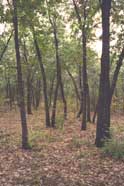
 |
Flatwoods occur on level ground underlain by a well-developed hardpan. A hardpan is a hardened layer of soil that prevents drainage. During the wet times of the year, a perched water table forms where there is hardpan beneath the surface soil. Water seeping down through the litter and surface soils cannot drain through the hardpan, and, as a result, these areas are often wet during the spring and fall.
|
Flatwoods in Illinois
In the central and southern portions of the state, flatwoods occur in the Illinoisan age glacial till (see timeline). They are underlain by a heavy, clay hardpan - an almost impermeable layer of fine-textured, hardened clay particles. The hardpan forms as fine clay particles, along with suspended minerals within the surface soil are leached down to the 'subsoil.
There are three types of flatwoods in Illinois: sand flatwoods, northern flatwoods, and southern flatwoods. Canopy cover in flatwoods is typically 50 to 80 percent
- The sand flatwoods are restricted to the sandy plains in northern Illinois, and are dominated by pin oak, white oak, black gum, and red maple. The substrate is acidic, peaty sand underlain by clay.
- The northern flatwoods occur on glacial moraines in northeastern Illinois and are dominated by white oak, swamp white oak, and American elm.
- The southern flatwoods occur from central to southern Illinois.
Because of the poor drainage, these forests are often flooded in the spring. Temporary pools form in depressions that are separated by dry or dry-mesic ridges. Plants and animals in flatwoods must adapt to strongly seasonal water availability because both flooded and droughty conditions occur during the growing season.
Wood rush (Cinna arundinaceae) and spike rush (Eleocharis tenuis var. verrucosa), both plants of wet or moist soils, along with bentgrass (Agrostis sp.) are characteristic of the understory vegetation in the southern flatwoods.
Flatwoods are an important amphibian-breeding habitat. In the northern flatwoods, the blue-spotted salamander is an example of a characteristic animal. In the southern flatwoods, the northern crawfish frog is a characteristic inhabitant.
Soil
nutrients in flatwoods forests
The hardpan forms a barrier to rooting. The majority of the trees in this community have shallow roots. Mineral nutrition is poor, as is soil aeration during the wet times of the year. As a result, many of the trees found in the flatwoods are stunted and have the ability to root sprout - as a response to stress or tissue damage.
Blackjack oak, post oak, and southern red oak, which typically occur on dry and poor soils, are dominant southern flatwoods trees. However, swamp white oak and pin oak, which are normally associated with moister soils, are also considered dominants in the southern flatwoods. Both types of trees gow here because of the mosaic of dry and wet micro-environments (the dry ridges and temporary pools) that is typical of flatwoods.
|
|
Copyright © 2000 Illinois State Museum